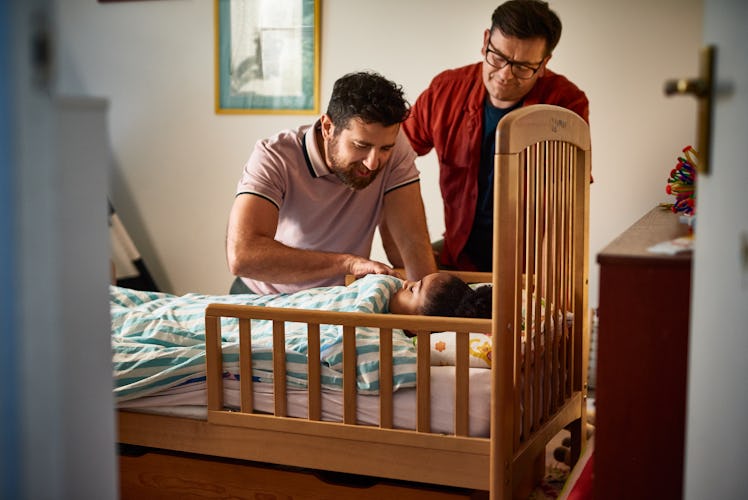How To Keep A Kid From Falling Out Of Bed
After transitioning to a big-kid bed, parents should consider bed placement and add-ons to keep a kid off the floor.

Generally, experts recommend that children transition to a toddler bed between ages 2 and 3, though some children begin escaping the crib — a prime indicator that they’re ready for a life beyond the bars — as early as 1 year old. But no matter what the bed-hopping scheduling ends up looking like, kids will never stop moving. When they’re in the crib, this can result in some stubbed toes and banged up bars. When they’re in the big-kid bed, this can result in a bump in the night followed by screams. That means parents need to take smart measures to keep their kids from hurting themselves as well as from waking up in the middle of the night.
“The older the child, the less risk there is of significant injury from falling out of bed,” says Amber Kroeker, the child injury prevention program coordinator at Randall Children’s Hospital in Portland, Oregon. “But it depends on the kind of bed they’re in.”
Whether starting the child off in a toddler bed or an adult bed, parents are strongly cautioned to make sure it isn’t so high that the kid needs a step stool to get in. After that, the best way to keep a toddler in a bed is fortifying the hell out of it.
If there are no electrical outlets or windows along perpendicular walls, wedge the bed firmly against the wall, which reduces the number of drop-off points to two. This practice is only recommended if there is no gap between the mattress and the wall, or the gap is so tiny that the child won’t become wedged. There’s a good reason for this, too: suffocation from entrapment.
It’s logical that when a gap does exist between a mattress and a wall, to want to stuff it with something soft, both to fill the space and to create a makeshift crash pad in the event of a fall. But Kroeker says that soft blankets and pillows can essentially function as quicksand, especially for a younger child who is just transitioning to a bed, or who might be too young to be alone without rails to begin with.
“Kids, especially very young ones, can fall into a down comforter and eventually suffocate,” says Kroeker. “Don’t use blankets, pillows, or other things in cracks to prevent bonks. Sometimes it’s preferential that they just fall on the floor, as opposed to getting wedged between the mattress and the wall.”
She suggests thinking of it like a morbid game of Tetris. A gap between the mattress or wall could be just the right size that a young child could roll in and become trapped. That makes pushing the bed against the wall the best solution.
Barring walls, there are endless options for parents to fortify beds in order to prevent a wild sleeper from flying off the edge. Toddler rails are readily available and serve to contain a toddler from rollover falls. Parents can also get creative, lining the sides of the bed with body pillows or rolled up pillows to create the bedtime equivalent of bumper bowling (just be careful with soft stuff around babies and very young children). But, again, this is only preferable for children over the age of 2 years old, for whom SIDS risks have diminished.
Parents can also ease into bigger beds one step at a time, essentially training their children to stay in the designated bed space while sleeping and slowly gaining height as they learn to stay on the mattress. Start by putting the crib mattress on the ground, then gradually transition to a toddler bed. Yes, they will likely fall. But prepared parents can control the difference between a frightened boo-boo and something far worse.
“Even if the kid rolls off onto hardwood floors, they might bonk their head, but that’s a very, very small concern,” says Kroeker. “If you’re concerned with a kid rolling off a toddler bed height, like 12 inches, you can get an area rug to cushion that fall. But falls from that height are not super concerning. It’s equal to your child falling from standing, which they do all the time.”
This article was originally published on